
There have been numerous different form factors and optics types introduced since 10 gigabit Ethernet has been launched years ago. XENPAKS, the oldest, is very popular as the install base is large, while the newest SFP+ offers a much smaller form factor and the ability to offer 1G/10G combo ports on hardware for the first time. Now there are four standard modules/form-factors available.
Main module types and optical standards
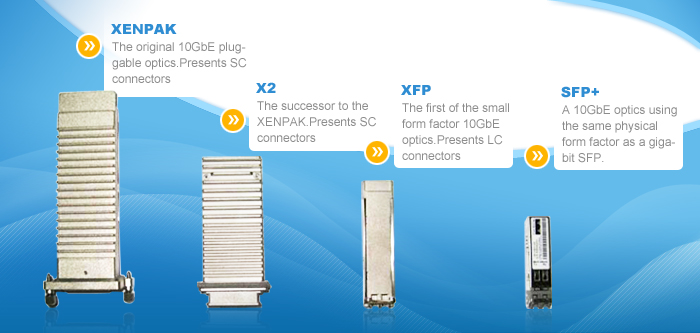
- Used primarily by Cisco and Juniper. The 4-port Cisco module WS-X6704-10GE is still very popular
- Very large module that includes some PHY logic in the package (example – WAN PHY capability on a XENPAK card is placed on the optic, while this capability on an XFP or SFP+ based interface is placed on the linecard)
- Uses SC connector for fiber or CX4 (Infiniband) for copper
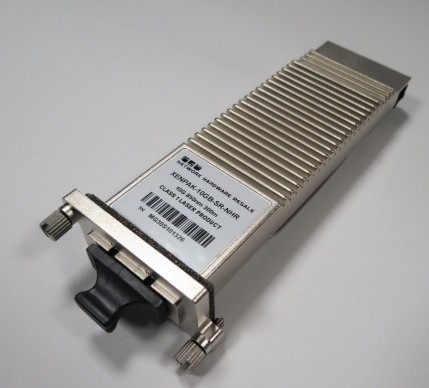
- Reduced-size evolution of the XENPAK
- Used almost exclusively by Cisco and HP
- Same general capabilities as XENPAK
- 30% reduced footprint allowed 10G port densities to increase by 2X and then 4X in Cisco modules
- Introduced a converter module to convert X2 modules to 2X1G or 1XSFP+ (please note the TwinGig converters have many compatibility restrictions)
- Uses SC connector for fiber or CX4 (Infiniband) for copper
- X2 form factor is the ONLY option for pluggable 10GbE-T
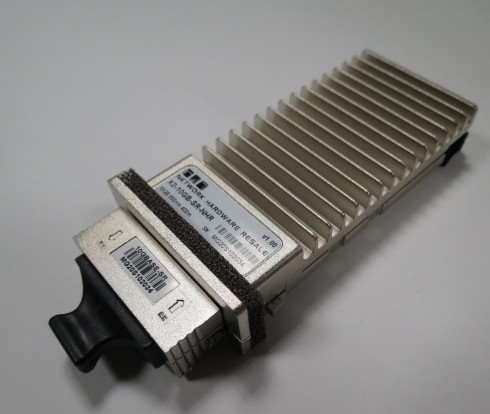
- Small form factor optic, no PHY logic
- Moving the PHY logic to the linecard gave made it possible to make 10G/OC192 dual-rate optics
- Uses LC fiber connector
- XFP is currently the smallest form factor tunable DWDM optic that is available
- Used mostly in WAN applications, due to dual-rate 10G/OC192 and Tunable DWDM offerings
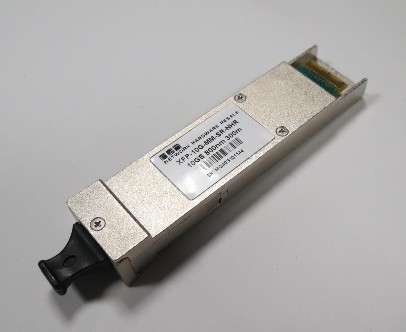
- •Same form factor as SFP
- •SFP+ ports are often 1G/10G, offering huge flexibility in deploying mixed environments
- (Note: some chassis have restrictions on which ports are 10G-only and which are 1G/10G)
- •All major vendors are moving towards SFP+ for common 10GbE applications, especially in the Data Center
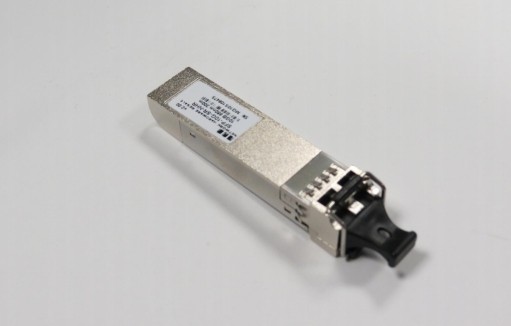
Within these form factors are many different types of optical and electrical specifications; the only requirement is that the optics type match. It is perfectly acceptable to connect an X2 to an SFP, or a XENPAK to an SFP+, or any other combination.
Optical Standards
Electrical/Copper
10GBase-CX4
CX4 modules use Infiniband 4X cabling, and have a maximum distance of 15 meters. CX4 is an early copper standard, and due to the physical size of the connector, is not available in SFP+ form, or in XFP form from Cisco (Force10, though, offers a CX4 XFP). CX4 was designed as a drop-in replacement for legacy Infiniband switching hardware – the existing Infiniband cable plant can be reused in a CX4 based network.
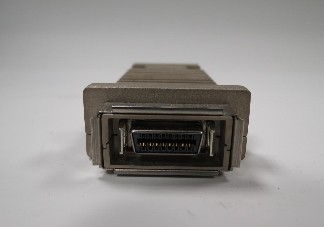
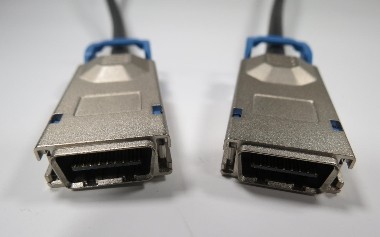
10GBase-CX1/10GBase-CU
10GBase-CX1 is the SFP+ copper standard. The standard has a maximum distance of 10 meters, though Cisco currently only offers lengths up to 5m. This is actually a cable with SFP+ ends, not a module with a separate cable.
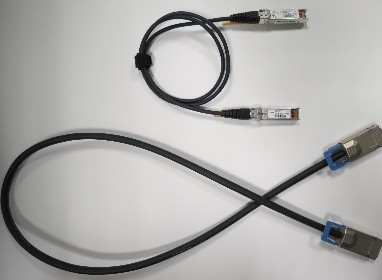
Notice that the cable is permanently integrated into the SFP+ ends. Because of this, both devices must present SFP+ ports. While the cables are somewhat inconvenient to work with due to the integration, CX1 modules are used due to a very low cost ($150-$200 per cable), extremely low power consumption (0.25W per cable), and a negligible latency penalty.
10GBase-T
Currently, there are no 10GBase-T pluggable optics. The only devices that present 10GBase-T ports do so in a fixed form factor, or via shared ports. Maximum distance, using Cat6a cable, is 100 meters. Use of older Cat6 cable reduces the maximum distance to 55 meters. The main drawback to 10GBase-T is the very high power consumption per port, around 6W per port for current devices. However, since it retains the incredibly simple cabling of other –T standards, 10GBase-T is likely to become much more popular in the coming years. Currently, Cisco only has 10GBase-T options in the Cisco 4900M and 6500 switches.
Multimode Fiber
10GBase-SR
10GBase-SR is the original multimode optics specification, and is still by far the most commonly used. As it uses a single, low cost solid state laser assembly, it is also the least expensive of the optical modules available for a 10GbE platform. However, 10GBase-SR is very sensitive to fiber type. Below is a list of cable specs and maximum distance with SR optics.
| Core Size (microns) | Modal Bandwidth (MHz*km) | Max Distance | Notes |
| 62.5 | 160 | 26m | This is standard multimode fiber. |
| 62.5 | 200 | 33m | |
| 50 | 400 | 66m | |
| 50 | 500 | 82m | |
| 50 | 2000 | 300m | Also known as OM3 or 10GbE-optimized fiber |
Because of this, it is highly recommended that any new deployment of multimode fiber be done with OM3 fiber. This will ensure an easier transition to 10GbE for future needs.
10GBase-LX4
To overcome the distance limitations of SR optics, the 10GBase-LX4 standard was developed. LX4 uses 4 lasers, each operating at a different wavelength, at a 2.5Gbps data rate. This results in a range of 240-300 meters, depending on cable grade. However, due to the complex laser assembly, it is not possible to get LX4 optics in XFP or SFP+ versions. With the ready availability of OM3 fiber and newer standards that provide long reach over multimode with a single laser, LX4 is rapidly becoming obsolete.
10GBase-LRM
The replacement to LX4, 10GBase-LRM will reach up to 220m over standard multimode fiber, but without the complexity of the LX4 optics. Instead, a single laser operating at 1310nm is used. This allows LRM optics to be packaged in XFP and SFP+ form factors.
Single mode Fiber
10GBase-LR
10GBase-LR can reach up to 10km over singlemode fiber. There is no minimum distance for LR, either, so it is suitable for short connections over single mode fiber as well.
10GBase-ER
10GBase-ER can reach up to 40km over singlemode fiber. Due to the laser power, attenuation is required for links less than 20km long.
10GBase-ZR
ZR optics can reach up to 80km over singlemode fiber. Due to the very high transmit power, significant attenuation is needed for shorter links. Use of ZR optics should be preceded with an optical power test of the fiber span in question to ensure a problem-free deployment. Interestingly, 10GBase-ZR is actually not an IEEE standard, though most vendors offer a ZR option.
10GBase-LW
10GBase-LW optics use the same laser, and have the same specifications as the 10GBase-LR optics. However, the LW optics present SONET/SDH physical signaling, allowing LW-equipped devices to interface directly with an existing OC192 transport infrastructure. LW optics are only available in XENPAK and X2 form factors. XFP-based cards move this functionality from the transicever to the card itself, so make sure that if this functionality is needed, that the card itself has this support. The primary example is the as in the SPA-1X10GE-L-V2 vs. the SPA-1X10GE-LW-V2.
10G over DWDM
With 10GbE, it is possible to get optics modules that output at DWDM wavelengths, allowing for much simpler DWDM deployments, and with this optics no additional transponder hardware is required. A select few 10GbE cards even offer fixed, tunable DWDM interfaces for maximum flexibility.
As one of the most confusing aspects of choosing and deploying 10Gig fiber switches, I hope this information helps. And a nod to our excellent presales engineers (thanks chris!) for putting this together for me for this article.
Quick Review of Optics Form Factors
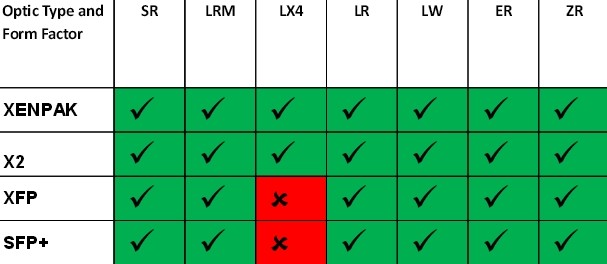
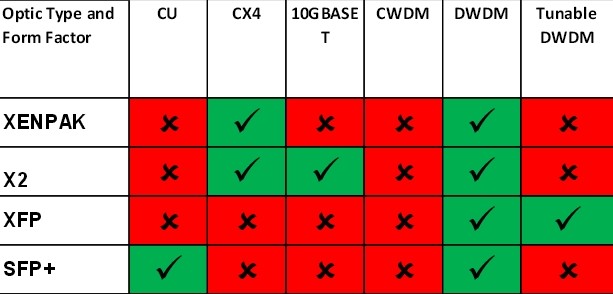
Optics Specs
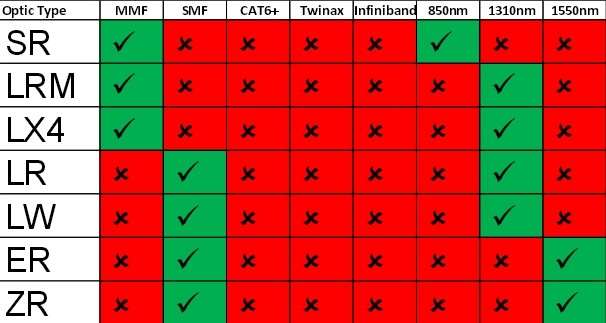
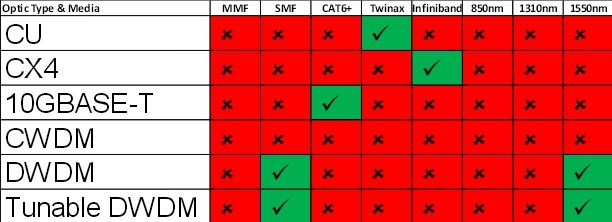
More about Cisco Modules:
Cisco 10GBASE SFP+ Modules Overview
Why Should We Care About 10 Gigabit Ethernet Pluggable Optics?
To Recognize Cisco Catalyst 6500 Series 8-Port 10 Gigabit Ethernet Module
Cisco Interface Cards for Cisco 1900, Cisco 2900 and Cisco 3900 Series
Cisco Catalyst 4500 Series Line Cards Overview


